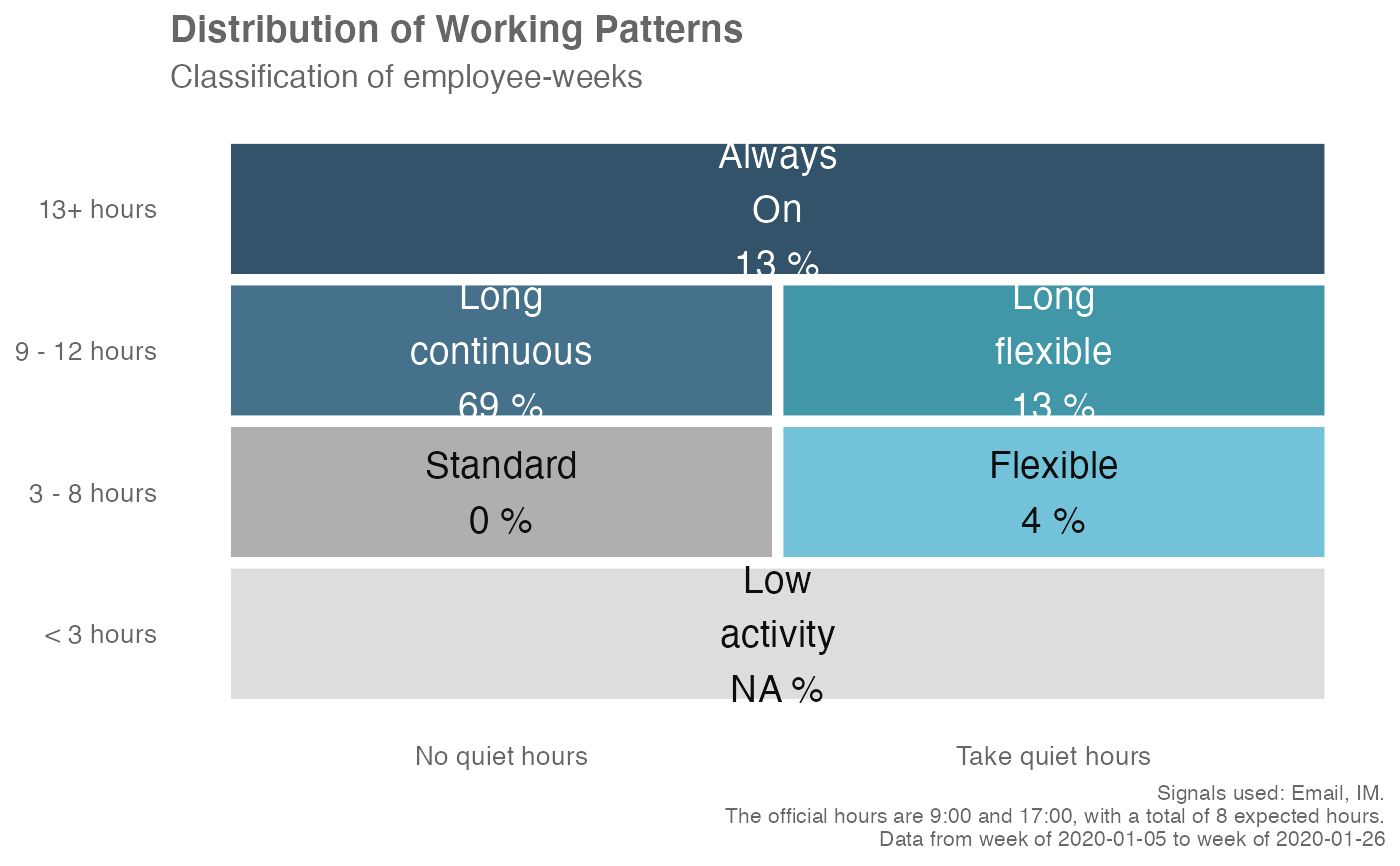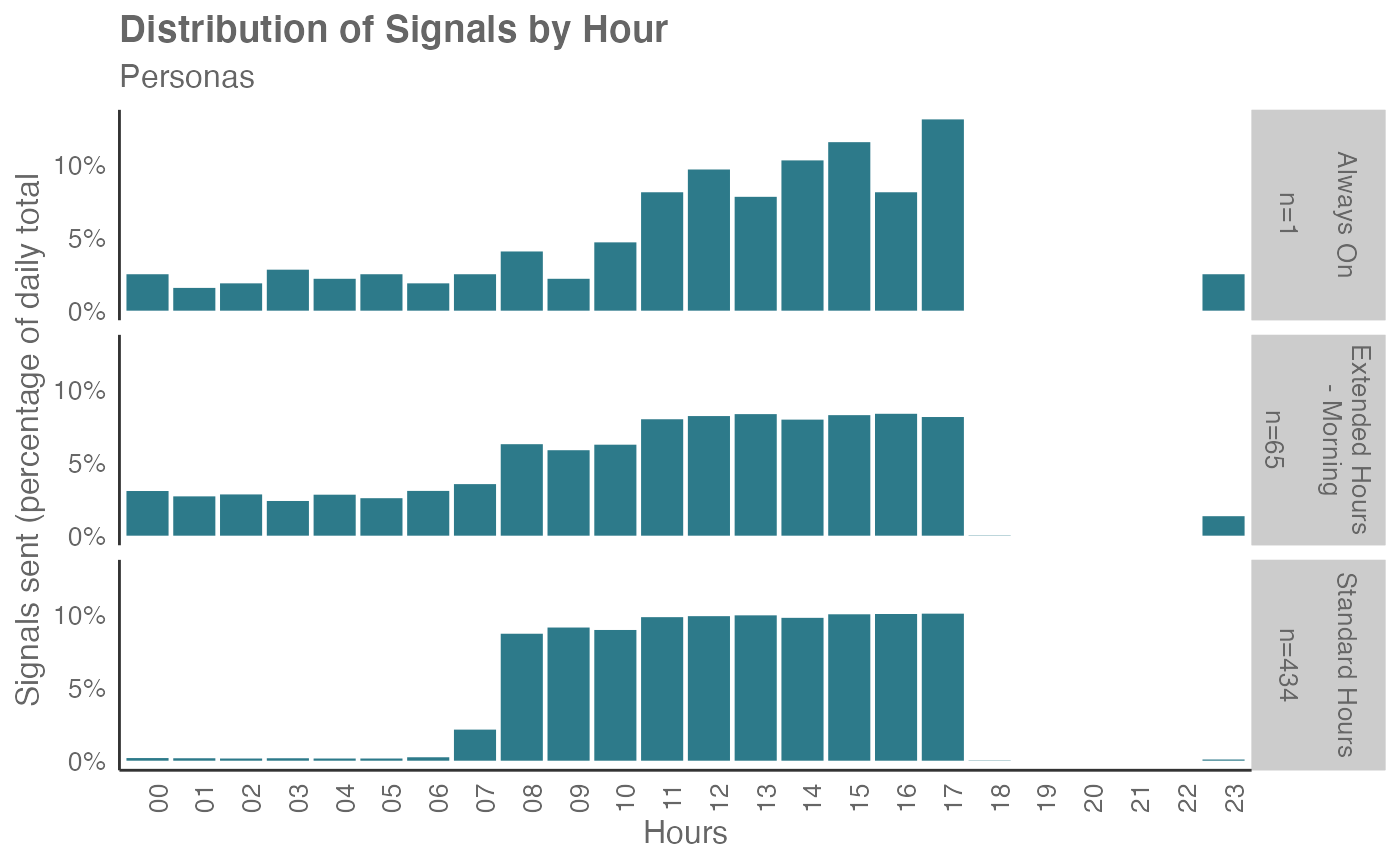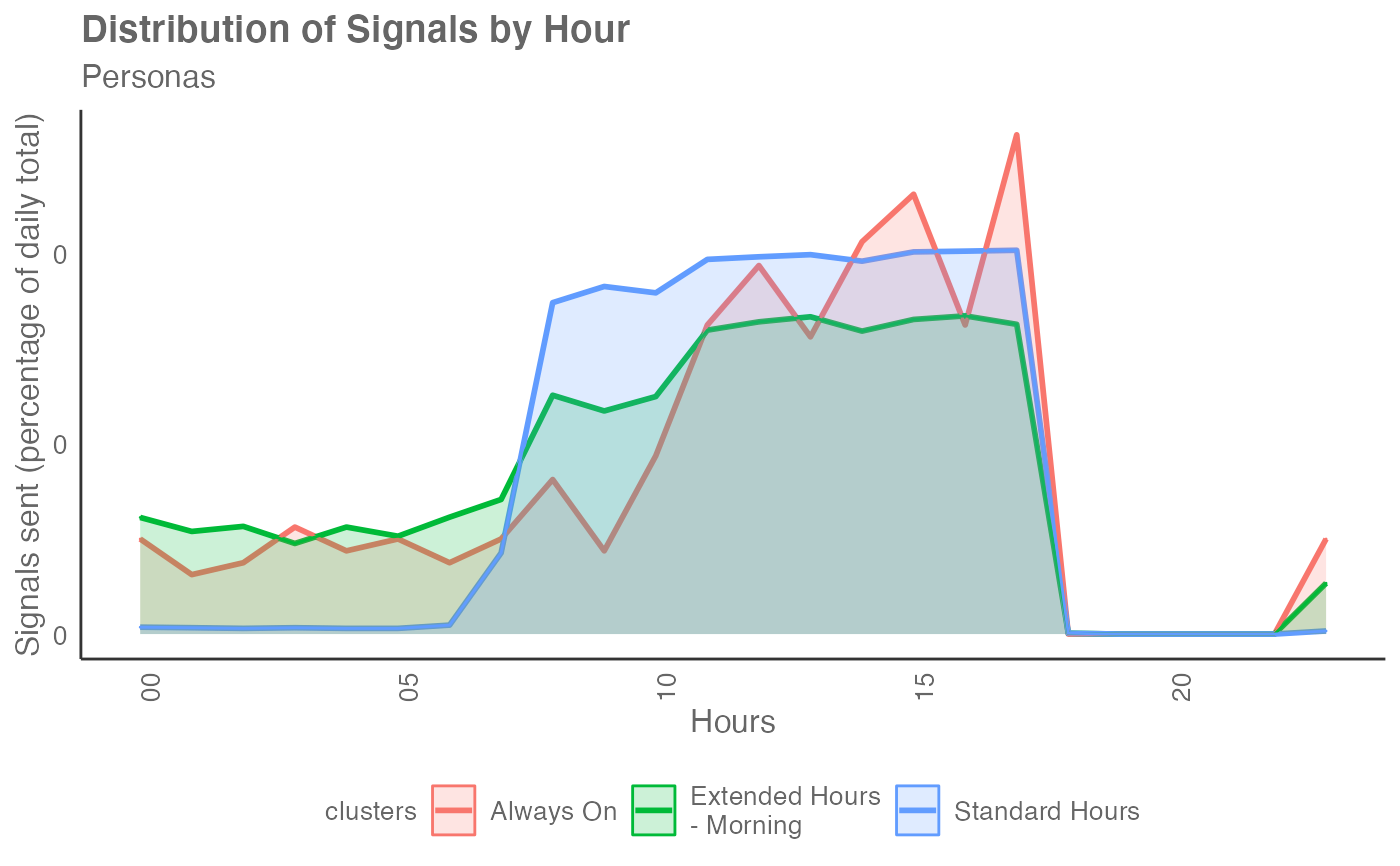Classify working pattern personas using a rule based algorithm
Source:R/workpatterns_classify.R
workpatterns_classify.RdApply a rule based algorithm to emails or instant messages sent by hour of day. Uses a binary week-based ('bw') method by default, with options to use the the person-average volume-based ('pav') method.
workpatterns_classify(
data,
hrvar = "Organization",
values = "percent",
signals = c("email", "IM"),
start_hour = "0900",
end_hour = "1700",
exp_hours = NULL,
mingroup = 5,
active_threshold = 0,
method = "bw",
return = "plot"
)Arguments
- data
A data frame containing data from the Hourly Collaboration query.
- hrvar
A string specifying the HR attribute to cut the data by. Defaults to
NULL. This only affects the function when"table"is returned, and is only applicable formethod = "bw".- values
Only valid if using
pavmethod. Character vector to specify whether to return percentages or absolute values in"data"and"plot". Valid values are"percent"(default) and"abs".- signals
Character vector to specify which collaboration metrics to use:
"email"(default) for emails only"IM"for Teams messages only"unscheduled_calls"for Unscheduled Calls only"meetings"for Meetings onlyor a combination of signals, such as
c("email", "IM")
- start_hour
A character vector specifying starting hours, e.g.
"0900". Note that this currently only supports hourly increments. If the official hours specifying checking in and 9 AM and checking out at 5 PM, then"0900"should be supplied here.- end_hour
A character vector specifying starting hours, e.g.
"1700". Note that this currently only supports hourly increments. If the official hours specifying checking in and 9 AM and checking out at 5 PM, then"1700"should be supplied here.- exp_hours
Numeric value representing the number of hours the population is expected to be active for throughout the workday. By default, this uses the difference between
end_hourandstart_hour. Only applicable with the 'bw' method.- mingroup
Numeric value setting the privacy threshold / minimum group size. Defaults to 5.
- active_threshold
A numeric value specifying the minimum number of signals to be greater than in order to qualify as active. Defaults to 0. Only applicable for the binary-week method.
- method
String to pass through specifying which method to use for classification. By default, a binary week-based (
bw) method is used, with options to use the the person-average volume-based (pav) method.- return
String specifying what to return. This must be one of the following strings:
"plot""data""table""plot-area""plot-hrvar"(only forbwmethod)"plot-dist"(only forbwmethod)
See
Valuefor more information.
Value
Character vector to specify what to return. Valid options include:
"plot": ggplot object. With thebwmethod, this returns a grid showing the distribution of archetypes by 'breaks' and number of active hours (default). With thepavmethod, this returns a faceted bar plot which shows the percentage of signals sent in each hour, with each facet representing an archetype."data": data frame. The raw data with the classified archetypes."table": data frame. A summary table of the archetypes."plot-area": ggplot object. With thebwmethod, this returns an area plot of the percentages of archetypes shown over time. With thepavmethod, this returns an area chart which shows the percentage of signals sent in each hour, with each line representing an archetype."plot-hrvar": ggplot object. A bar plot showing the count of archetypes, faceted by the supplied HR attribute. This is only available for thebwmethod."plot-dist": returns a heatmap plot of signal distribution by hour and archetypes. This is only available for thebwmethod.
Details
The working patterns archetypes are a set of segments created based on the aggregated hourly activity of employees. A motivation of creating these archetypes is to capture the diversity in working patterns, where for instance employees may choose to take multiple or extended breaks throughout the day, or choose to start or end earlier/later than their standard working hours. Two methods have been developed to capture the different working patterns.
This function is a wrapper around workpatterns_classify_bw() and
workpatterns_classify_pav(), and calls each function depending on what is
supplied to the method argument. Both methods implement a rule-based
classification of either person-weeks or persons that pull apart
different working patterns.
See individual sections below for details on the two different implementations.
Binary Week method
This method classifies each person-week into one of the eight archetypes:
0 Low Activity (< 3 hours on): fewer than 3 hours of active hours
1.1 Standard continuous (expected schedule): active hours equal to expected hours, with all activity confined within the expected start and end time
1.2 Standard continuous (shifted schedule): active hours equal to expected hours, with activity occurring beyond either the expected start or end time.
2.1 Standard flexible (expected schedule): active hours less than or equal to expected hours, with all activity confined within the expected start and end time
2.2 Standard flexible (shifted schedule): active hours less than or equal to expected hours, with activity occurring beyond either the expected start or end time.
3 Long flexible workday: number of active hours exceed expected hours, with breaks occurring throughout
4 Long continuous workday: number of active hours exceed expected hours, with activity happening in a continuous block (no breaks)
5 Always on (13h+): number of active hours greater than or equal to 13
Standard here denotes the behaviour of not exhibiting total number of
active hours which exceed the expected total number of hours, as supplied by
exp_hours. Continuous refers to the behaviour of not taking breaks,
i.e. no inactive hours between the first and last active hours of the day,
where flexible refers to the contrary.
This is the recommended method over pav for several reasons:
bwignores volume effects, where activity volume can still bias the results towards the 'standard working hours'.It captures the intuition that each individual can have 'light' and 'heavy' weeks with respect to workload.
The notion of 'breaks' in the 'binary-week' method is best understood as 'recurring disconnection time'. This denotes an hourly block where there is consistently no activity occurring throughout the week. Note that this applies a stricter criterion compared to the common definition of a break, which is simply a time interval where no active work is being done, and thus the more specific terminology 'recurring disconnection time' is preferred.
In the standard plot output, the archetypes have been abbreviated to show the following:
Low Activity - archetype 0
Standard - archetypes 1.1 and 1.2
Flexible - archetypes 2.1 and 2.2
Long continuous - archetype 4
Long flexible - archetype 3
Always On - archetype 5
Person Average method
This method classifies each person (based on unique PersonId) into
one of the six archetypes:
Absent: Fewer than 10 signals over the week.
Extended Hours - Morning: 15%+ of collaboration before start hours and less than 70% within standard hours, and less than 15% of collaboration after end hours
Extended Hours - Evening: Less than 15% of collaboration before start hours and less than 70% within standard hours, and 15%+ of collaboration after end hours
Overnight workers: less than 30% of collaboration happens within standard hours
Standard Hours: over 70% of collaboration within standard hours
Always On: over 15% of collaboration happens before starting hour and end hour (both conditions must satisfy) and less than 70% of collaboration within standard hours
Flexibility Index
The Working Patterns archetypes as calculated
using the binary-week method shares many similarities with the Flexibility
Index (see flex_index()):
Both are computed directly from the Hourly Collaboration Flexible Query.
Both apply the same binary conversion of activity on the signals from the Hourly Collaboration Flexible Query.
See also
Other Clustering:
personas_hclust(),
workpatterns_hclust()
Other Working Patterns:
flex_index(),
identify_shifts(),
identify_shifts_wp(),
plot_flex_index(),
workpatterns_area(),
workpatterns_classify_bw(),
workpatterns_classify_pav(),
workpatterns_hclust(),
workpatterns_rank(),
workpatterns_report()
Examples
# \donttest{
# Returns a plot by default
em_data %>% workpatterns_classify(method = "bw")
 # Return an area plot
# With custom expected hours
em_data %>%
workpatterns_classify(
method = "bw",
return = "plot-area",
exp_hours = 7
)
# Return an area plot
# With custom expected hours
em_data %>%
workpatterns_classify(
method = "bw",
return = "plot-area",
exp_hours = 7
)
 em_data %>% workpatterns_classify(method = "bw", return = "table")
#> # A tibble: 5 × 17
#> Personas `Biz Dev` `Customer Service` Facilities `Finance-Corporate`
#> <fct> <dbl> <dbl> <dbl> <dbl>
#> 1 1.2 Standard cont… NA NA 0.00806 NA
#> 2 2.2 Standard flex… NA NA 0.105 0.0735
#> 3 3 Long flexible w… 0.111 0.0938 0.0565 0.0956
#> 4 4 Long continuous… 0.880 0.885 0.758 0.75
#> 5 5 Always on (13h+) 0.00926 0.0208 0.0726 0.0809
#> # ℹ 12 more variables: `Finance-East` <dbl>, `Finance-South` <dbl>,
#> # `Finance-West` <dbl>, `Financial Planning` <dbl>, `G&A Central` <dbl>,
#> # `G&A East` <dbl>, `G&A South` <dbl>, `Human Resources` <dbl>,
#> # `IT-Corporate` <dbl>, `IT-East` <dbl>, `Inventory Management` <dbl>,
#> # Total <dbl>
em_data %>% workpatterns_classify(method = "pav")
em_data %>% workpatterns_classify(method = "bw", return = "table")
#> # A tibble: 5 × 17
#> Personas `Biz Dev` `Customer Service` Facilities `Finance-Corporate`
#> <fct> <dbl> <dbl> <dbl> <dbl>
#> 1 1.2 Standard cont… NA NA 0.00806 NA
#> 2 2.2 Standard flex… NA NA 0.105 0.0735
#> 3 3 Long flexible w… 0.111 0.0938 0.0565 0.0956
#> 4 4 Long continuous… 0.880 0.885 0.758 0.75
#> 5 5 Always on (13h+) 0.00926 0.0208 0.0726 0.0809
#> # ℹ 12 more variables: `Finance-East` <dbl>, `Finance-South` <dbl>,
#> # `Finance-West` <dbl>, `Financial Planning` <dbl>, `G&A Central` <dbl>,
#> # `G&A East` <dbl>, `G&A South` <dbl>, `Human Resources` <dbl>,
#> # `IT-Corporate` <dbl>, `IT-East` <dbl>, `Inventory Management` <dbl>,
#> # Total <dbl>
em_data %>% workpatterns_classify(method = "pav")
 em_data %>% workpatterns_classify(method = "pav", return = "plot-area")
em_data %>% workpatterns_classify(method = "pav", return = "plot-area")
 # }
# }